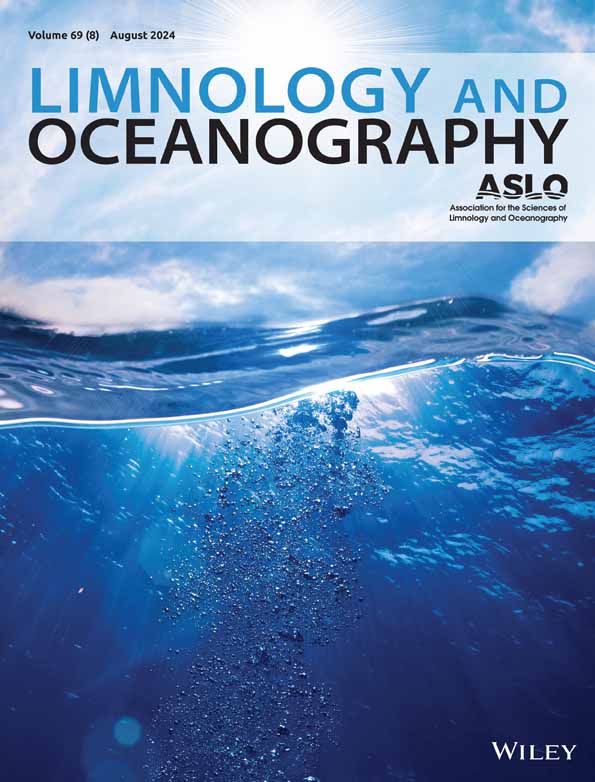浮游幼虫阶段——适应远洋环境中较低的捕食率?
IF 3.7
1区 地球科学
Q1 LIMNOLOGY
引用次数: 0
摘要
大多数海洋底栖大型无脊椎动物和鱼类都有浮游幼虫阶段,在水柱中分散几天到几个月。然而,远洋幼虫的适应意义,以及在远洋还是底栖环境中捕食率更高,仍然存在争议,部分原因是缺乏评估近海、远洋栖息地中幼虫捕食率的研究。在这里,我们利用系绳技术评估了北海东部海岸巨蟹(Carcinus maenas)的捕食死亡率,比较了五种不同底栖动物和远洋栖息地捕食率的差异,在2年的时间里系绳了近900只巨蟹。结果表明,浅底栖生境(0.5-4 m深度,23-58% 6 h−1)对滨蟹的相对捕食率比近岸和近海生境(10 - 100 m深度,5-7% 6 h−1)高10倍。这一模式在这两年的白天和黑夜条件下都是一致的,在包括黄昏和黎明的24小时实验中也是一致的。浅层底栖区较高的捕食率可能是该栖息地潜在捕食者丰度比远洋环境高3至4个数量级的直接影响。该研究首次证明了远洋环境中捕食率较低的数量级,为浮游生物幼虫可能适应远洋环境作为空间避难所,以躲避浅层苗圃栖息地的高捕食率提供了新的支持。本文章由计算机程序翻译,如有差异,请以英文原文为准。
Planktonic larval stages—an adaptation to lower predation rates in the pelagic environment?
A majority of marine benthic macroinvertebrate and fish species have planktonic larval stages that disperse in the water column from days to months. However, the adaptive significance of pelagic larvae, and whether predation is higher in the pelagic or the benthic environment, is still debated, partly due to a lack of studies assessing larval predation in offshore, pelagic habitats. Here we assess predation mortality on shore crab megalopae (Carcinus maenas ) using tethering techniques in the eastern North Sea, comparing diel differences in predation rates in five different benthic and pelagic habitats, tethering close to 900 megalopae over a 2‐year period. Our results showed that relative predation rates on shore crab megalopae were up to 10 times higher in shallow benthic nursery habitats (0.5–4 m depth; 23–58% 6 h−1 ) compared to nearshore and offshore pelagic habitats (10–100 m depth; 5–7% 6 h−1 ). This pattern was consistent both during day and night conditions in both years, and also in a 24‐h experiment when the periods of dusk and dawn were included. The higher predation rates in shallow benthic areas were likely a direct effect of an estimated 3 to 4 orders of magnitude higher abundance of potential predators in this habitat compared to the pelagic environment. By demonstrating an order of magnitude lower predation rates in a pelagic offshore environment for the first time, the study provides new support that planktonic larvae may be an adaptation to use pelagic environments as a spatial refuge from high predation rates in shallow nursery habitats.
求助全文
通过发布文献求助,成功后即可免费获取论文全文。
去求助
来源期刊

Limnology and Oceanography
地学-海洋学
CiteScore
8.80
自引率
6.70%
发文量
254
审稿时长
3 months
期刊介绍:
Limnology and Oceanography (L&O; print ISSN 0024-3590, online ISSN 1939-5590) publishes original articles, including scholarly reviews, about all aspects of limnology and oceanography. The journal''s unifying theme is the understanding of aquatic systems. Submissions are judged on the originality of their data, interpretations, and ideas, and on the degree to which they can be generalized beyond the particular aquatic system examined. Laboratory and modeling studies must demonstrate relevance to field environments; typically this means that they are bolstered by substantial "real-world" data. Few purely theoretical or purely empirical papers are accepted for review.
 求助内容:
求助内容: 应助结果提醒方式:
应助结果提醒方式:


